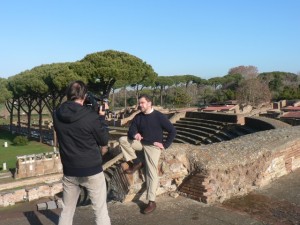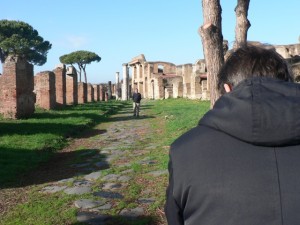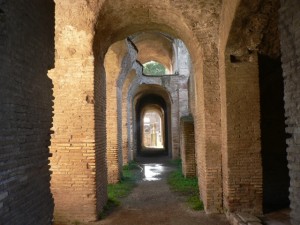Archeologists may have found the site of a sixth-century miracle recorded by Procopius in his account of The Buildings of Justinian. The story broke in Haaretz, but is told more fully at Patheos. Out of the stone at the miraculous quarry Justinian built a church to the Blessed Virgin Mary — twice the size of Jerusalem’s Temple.
Category: Archeology
Dig These Finds
The past is more present than it’s been in ages. Archeological discoveries have been piling up in my basket. Here’s a great one that’s very patristic.
Bulgarian archaeologists have uncovered what they believe is the oldest Christian monastery in Europe near the village of Zlatna Livada in southern Bulgaria.
According to latest archaeological research, the St. Athanasius monastery, still functioning near the village, has been founded in 344 by St. Athanasius himself, reports the BGNES agency.
Until now, the Candida Casa monastery, founded in 371 AD in Galloway, Scotland, was believed to be the oldest Christian monastery in Europe, followed by the St. Martin monastery in the Pyrénées-Orientales, France (373 AD).
Archaeologists have examined objects in a hermit’s cave and shrine located near the present St. Athanasius monastery in Bulgaria, and found evidence that the great saint might have resided there.
Additional studies in archives at the Vatican have confirmed that St. Athanasius was present at the Church Council in Serdica (modern Sofia) in 343 AD.
He then travelled on to Constantinople and is believed to have stopped in the area of present Zlatna Livada, which is located in Thrace on the ancient way between Serdica and Constantinople.
Some others, too:
Bible History Daily: Ancient Gravestone Epitaphs Give Insight into Early Jews and Christians.
New Book on Early Christian Art
Some years back I collaborated with the Czech artist Lea Ravotti on the book Signs and Mysteries: Revealing Ancient Christian Symbols. Readers of that book might be interested in this title just out by Anastasia Lazaridou: Transition to Christianity: Art of Late Antiquity, 3rd-7th Century AD.
If you don’t know Signs and Mysteries, though, do check it out, if only for Lea’s artwork! (If I hadn’t given up punning for Lent, I would have said czech it out. Isn’t that prague-ress? … Oh, there I go again, back to Ash Wednesday.)
Ghost Towns of Byzantine Syria
Suburban Banshee (aka Maureen) points us to a stunning page of photos of the ghost towns of Byzantine Syria. I find these sites fascinating, and I’ve blogged about them before — here, here, and here.
Harboring Fugitives
A new find in Turkey promises to be as wonderful as Ostia Antica is in Italy. Here’s a bit of the New York Times’ take.
The find is Bathonea, a substantial harbor town dating from the second century B.C. Discovered in 2007 after a drought lowered the lake’s water table, it has been yielding a trove of relics from the fourth to the sixth centuries A.D., a period that parallels Istanbul’s founding and its rise as Constantinople, a seat of power for three successive empires — the Eastern Roman, Byzantine and Ottoman.
… Bathonea (pronounced bath-oh-NAY-uh) has the potential to become a “library of Constantinople,” says Sengul Aydingun, the archaeologist who made the initial discovery…
Roman glass and high-end pottery dating as late as the 14th century were found throughout the site. Marble, including a gorgeous milky-blue variety, lined the walls and floors of the church and at least one of the buildings.
Also discovered were hundreds of bricks stamped “Konstans,” which were produced in Constantinople beginning in the fifth century and had mostly been discovered at imperial sites like Hagia Sophia, the sixth-century architectural marvel and primary cathedral of the Byzantine Empire for almost 900 years, and nearby Rhegion, a fifth-century compound on a hill across the lake from Bathonea, overlooking the Marmara Sea.
Read the rest of the story.
Keeping Copts in Mind
As Egypt’s Christians face an uncertain future, their most ancient ancestors rise from the sand to remind them of the faith that withstood Decius and Diocletian … and remind us to pray for the Copts. Check out this recent discovery.
A Supreme Council of Antiquities mission has discovered a Coptic city dating back to the fourth century. The city is located in the Ain al-Sabil area of the New Valley Governorate.
In the middle of the city, a basilica church was found, surrounded by buildings that Council Secretary General Mostafa Amin said were service units for the priests.
“We never had an excavation in Ain al-Sabil before,” said Amin. “Maybe we’ll find other antiquities that would add to Egypt’s archaeological treasures.”
Mohsen Ali, the council’s director of Islamic and Coptic antiquities, said the mission also uncovered a house that consists of a big hall, living rooms, a main entrance, a kitchen with a built-in oven and an intact staircase, in addition to ancient bronze coins and clay jugs.
A Coptologist friend of mine writes, in joyful hope: “Where coins are left behind, fourth or third century papyrus may be found in the basilica!”
Curses!
LiveScience reports on a curse tablet found in Antioch (Antakaya), near Turkey’s border with Syria. It calls upon Yahweh to visit his wrath upon a greengrocer named Babylas.
One of Antioch’s great martyr-bishops was named Babylas. His relics were evicted by Julian the Apostate, who worried that they were causing radio interference with the demons who fed the local pagan oracles.
There couldn’t be a connection.
Such cursing is a curious part of late-antique cultures. Some years ago I posted on the Church Fathers and the evil eye. Don’t try this at home. Or anywhere.
Visiting Old Ostia
I spent a few days in Italy in the first week of December, shooting on-site for a documentary on the life of St. Augustine. It was great fun. By far my favorite part was our day spent in Ostia Antica, where Augustine tended to his mother, St. Monica, during her last illness. Ostia Antica has only recently been excavated, and it’s remarkably intact. In his Confessions, Augustine tells how he felt out of sorts on the day of Monica’s funeral, and so he walked to the baths and then home to take a nap. In Ostia Antica you can kind of retrace his steps, moving from the Christian basilica to the baths and then to a residential neighborhood, where the homes appear to match the saint’s description of the place where he and his friends and family stayed. It’s a powerful experience, giving a pilgrim the opportunity to enter imaginatively (and even physically) into one of the great classic scenes of ancient Christian literature. Another plus: it’s far from the madding crowds of Rome. Nobody goes there, I’m told. So it’s pretty quiet, and you have the ancient streets to yourself — and the saints.
Imagine my delight, on Christmas day, when I saw a feature story on Ostia Antica in the New York Times. (The same paper had run a nice feature when the ruins were first open to the public, a few years back.) Tolle, lege — take up and read!
Here are some glam shots taken by my producer-director, Robert Fernandez, while I was on location.



Adrian Murdoch’s also been blogging on Ostia. He shows that the ruins can really accommodate all necessities.
Why We Hoard Books
At last, an ancient Christian book-owner gets credit where credit’s due.
AnneMarie Luijendijk of Princeton University has identified the owner of a Greek New Testament papyrus as Aurelius Leonides, a flax merchant from Egypt. Discovered in the late 19th century at Oxyrhynchus, Egypt, the papyrus contains verses 1-7 of Paul’s Letter to the Romans.
“It is the first and only ancient instance where we know the owner of a Greek New Testament papyrus,” writes Luijendijk in the Journal of Biblical Literature. “For most early New Testament manuscripts, we do not know where they were found, let alone who had owned them,” she continues.
I read and loved Luijendijk’s book Greetings in the Lord: Early Christians and the Oxyrhynchus Papyri (Harvard Theological Studies). Trolling in that glorious garbage dump in the “town of the sharp-snouted fish,” Dr. Luijendijk gathered the remains of a church that was hierarchical, richly liturgical, and deeply learned. Her study of the use of the word “Papas” — both “pope” and “father” — is illuminating.
God rest Aurelius Leonides for the care he took with this book. Surely he had to keep thousands in order for one to have survived. That’s what I’ll tell my wife.
Emperors’ New Close-Ups
Adrian Murdoch is posting an informative and entertaining video series on the Roman emperors. “The idea is to cover every Roman emperor from Augustus to Romulus Augustulus in under two minutes. A new episode will be published on a Monday morning. By the end of the year we should be in the middle of the third century.” Adrian supplements his summary lectures with nice shots of art and ruins. Check out the Augustus. It’s a minute and twenty-three seconds well spent.
From Chi Rho to Cairo
Egypt’s Al Ahram has posted coverage of the big Coptic exhibit I mentioned several days ago.
Finds of the Pre-Islamic Times
The Media Line and Catholic News agency both reported on an ancient Christian site dug up in Abu Dhabi. It’s now open to tourists and pilgrims, “offering … a rare glimpse into the Islamic emirate’s often-forgotten Christian past.”
This is welcome news — and stands in stark contrast to the situation in other lands. A month ago, Jim Davila commented on an eye-opening essay at Huffington Post, Sabria Jawhar’s Saudis Struggle With How to Treat Pre-Islamic Artifacts Unearthed in Saudi Arabia. Apparently, when relics of early Judaism and Christianity are found in Saudi Arabia, they’re often destroyed.
Exercise Your Coptic Optic
Prepare to be wowed: Egypt’s Supreme Council of Antiquities has sponsored an exhibit of ancient Coptic art and artifacts. Drop in and take the online “exhibition tour.”
If you want a Coptic exhibit to have and hold, check out the book Picturing the Bible: The Earliest Christian Art, which I review here.
Last-Minute Beautiful Gifts
If you’re looking for a beautiful, substantial gift to give for Christmas, consider a book on ancient Christian art. Here are some relatively recent releases:
Picturing the Bible: The Earliest Christian Art, which I review here.
The Treasures of Coptic Art in the Coptic Museum and Churches of Old Cairo, which I review here.
The Christian Catacombs of Rome: History, Decoration, Inscriptions, which I review here.
And, of course, Signs and Mysteries: Revealing Ancient Christian Symbols — to decode it all!
Icon See for Miles and Miles
Happy Feast of St. John of Damascus — the great champion of divine images! As if to mark the day, archeologists in Syria announced the discovery of some ancient Christian graves with artifacts.
You’ll find lots on St. John by surfing and searching around the site. Maybe start here and here.